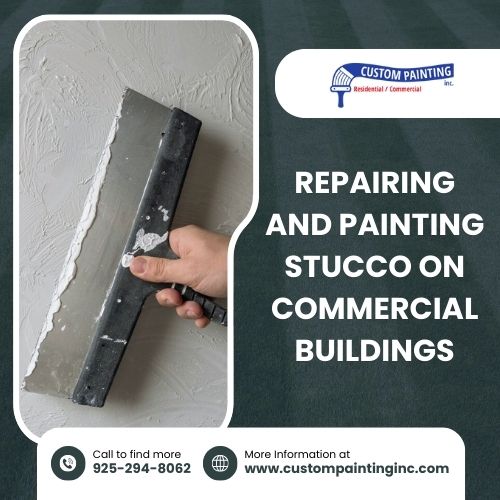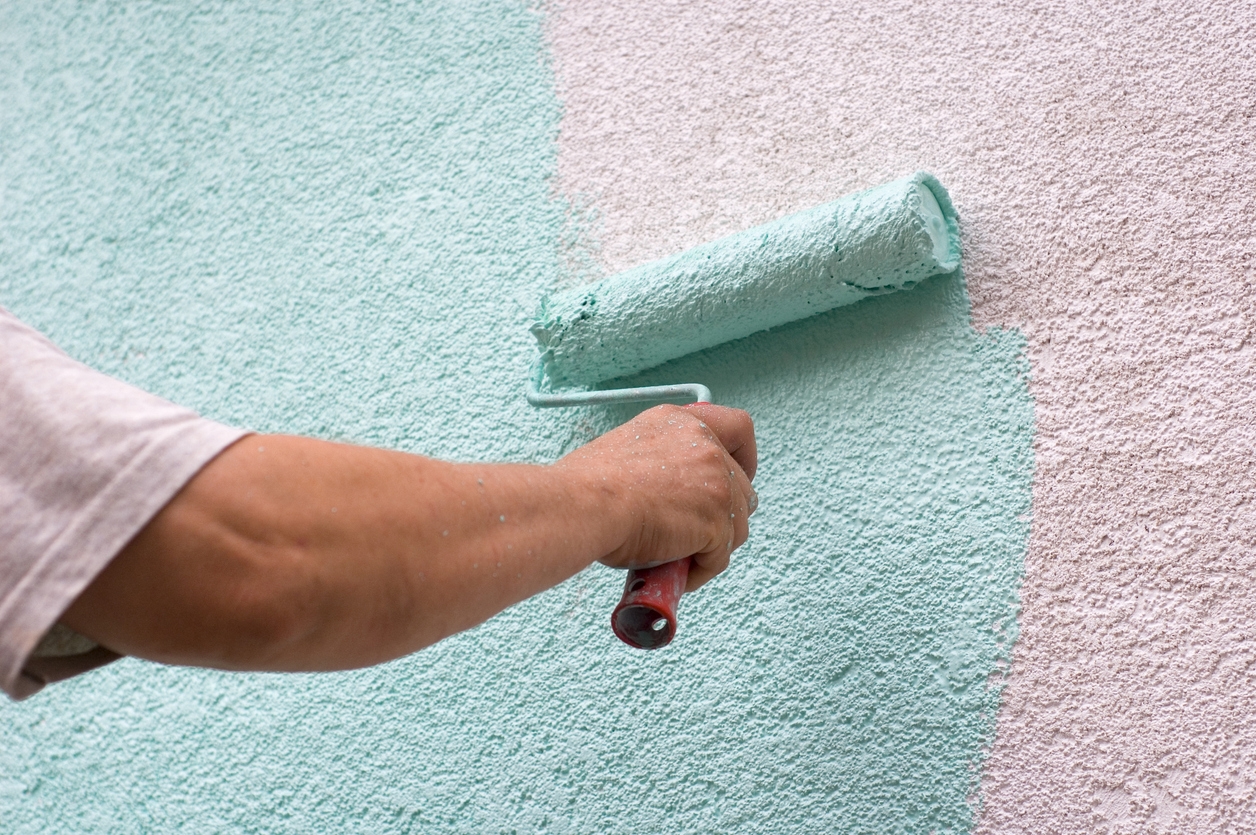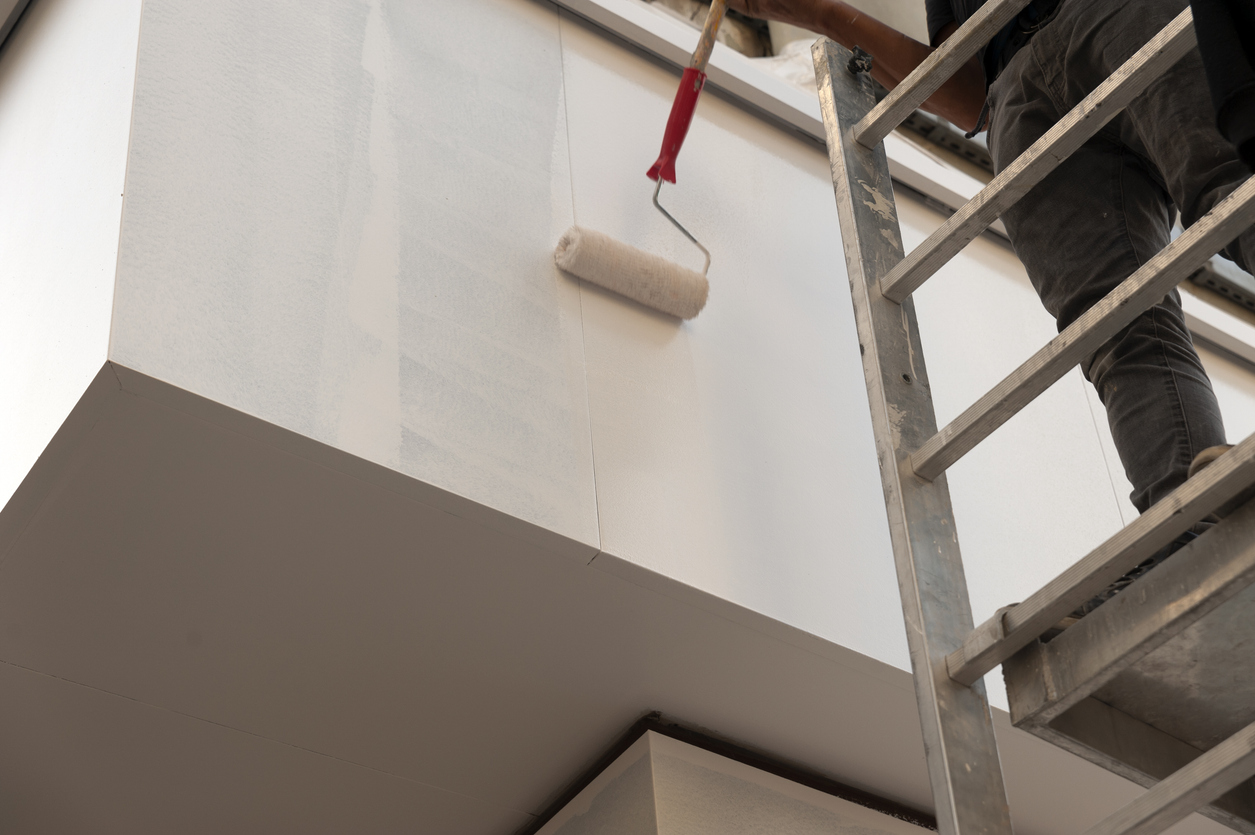Stucco is a popular choice for commercial buildings, valued for its durability and timeless appeal. However, maintaining stucco surfaces is essential to preserve their integrity and enhance the building’s overall appearance. Restore and refresh your building’s exterior with comprehensive commercial stucco repair and paint services.
Regular stucco repair and painting help address cracks, chips, or weather damage. They also offer numerous benefits. These include improved aesthetics, ensuring the property remains visually appealing and professional, enhanced durability to protect against further deterioration, and increased building value by maintaining its structural and market appeal. Proactive care ensures the longevity and functionality of this versatile material.
Understanding stucco in commercial buildings
What is stucco, and why is it commonly used?
Stucco is a cement-based plaster material applied over surfaces like brick, concrete, or metal lath. In commercial construction, it’s valued for its aesthetic appeal, durability, and cost-effectiveness. Its seamless finish offers a professional look suitable for various architectural styles.
Benefits of stucco
- Durability: Stucco is long-lasting and resistant to cracking, making it ideal for high-traffic and demanding environments.
- Versatility: It can be applied to curved or flat surfaces and colored or textured to suit design needs.
- Weather resistance: With proper sealing, stucco can withstand harsh weather conditions, including rain, wind, and sun.
Popular stucco finishes in commercial settings:
- Smooth finish: Modern and sleek, ideal for contemporary designs.
- Textured finish: Adds visual interest, often used in retail or hospitality settings.
- Dash finish: A rough, speckled look, offering a rustic appeal.
- Sand finish: A classic, evenly textured appearance suitable for versatile applications.
Stucco’s adaptability makes it a preferred choice in commercial construction, blending practicality with style.
Common problems with stucco and their causes
Cracks
Stucco cracks often result from structural settling, which occurs as a building naturally shifts over time. Impact damage, such as from objects hitting the surface, can also create cracks. Additionally, weather exposure, particularly extreme temperature changes, can cause expansion and contraction in the material, leading to cracking.
Water damage
Stucco is porous. If you do not seal it properly, moisture can penetrate the surface. It leads to problems like mold, mildew, and wood decay in underlying structures. Poor installation or damaged flashing can exacerbate water infiltration.
Fading and discoloration
Prolonged exposure to UV rays and environmental pollution can degrade the pigments in stucco, causing it to lose its original color. Acid rain and other pollutants can also contribute to uneven discoloration.
Chipping and flaking
As stucco ages, it can become brittle, making it more susceptible to chipping and flaking. Impacts, such as from debris or wear and tear, can worsen this issue. Improper maintenance, including harsh cleaning methods or lack of repainting, can accelerate deterioration.
Preparing for stucco repair and painting
1. Inspection and assessment
Importance:
- A thorough inspection ensures you address all areas of damage before repairing or painting. Neglecting hidden or minor damage can lead to peeling paint or further structural issues.
Steps:
- Walk around the exterior and visually inspect the stucco surface for cracks, holes, chips, or bulges.
- Look for signs of water damage, mildew, or efflorescence (white powdery deposits).
- Use a moisture meter if you suspect water infiltration.
- Tap the stucco lightly; hollow sounds may indicate delamination or structural issues beneath the surface.
- Mark damaged areas for easier identification during repairs.
2. Cleaning
Why it’s important
Proper cleaning ensures the repair materials and paint adhere well and remove contaminants that can compromise durability.
Steps:
Pressure washing:
- Use a pressure washer with a wide-angle spray tip to clean the stucco thoroughly.
- Keep the nozzle at a safe distance (12-18 inches) to avoid damaging the surface.
Manual cleaning:
- For areas with stubborn dirt or mold, use a scrub brush and mild detergent mixed with water.
- For mildew or mold, a mixture of water and bleach (1:3 ratio) can be applied, followed by rinsing.
Remove flaking paint
- Use a wire brush or scraper to remove loose or peeling paint from the surface.
Dry completely
- Allow the stucco to dry before repairing it to avoid trapping moisture.
3. Surface preparation
Importance:
Proper preparation creates a uniform surface for repairs and ensures the paint adheres evenly, improving the finish’s appearance and longevity.
Steps:
Remove loose material:
- Use a chisel, hammer, or stucco scraper to remove loose, crumbling, or damaged stucco.
- Brush away dust and debris from the exposed area.
Patch damaged areas:
- Mix stucco repair material or purchase a pre-mixed patching compound suitable for stucco.
- Apply the patching compound using a trowel, ensuring the material fills cracks, holes, or voids.
- For larger cracks, apply in layers, allowing each layer to dry before adding the next.
Smooth out surfaces:
- Feather the edges of the patched areas to blend with the existing stucco using a finishing trowel or sponge.
- Use a texture roller, brush, or trowel to match the texture of the surrounding stucco for a seamless look.
Prime the surface:
- Once repairs are dry, apply a masonry or stucco primer to ensure consistent paint application and seal the surface.
The stucco repair process
1. Filling cracks and holes
Techniques:
- Cleaning the area: Clean the damaged area with a wire brush to remove loose stucco, dirt, or debris. For deep cracks, widen them slightly with a chisel or utility knife to allow for better filler adhesion.
- Using elastomeric sealants: Elastomeric sealants are flexible and ideal for filling hairline cracks because they expand and contract with temperature changes, preventing further cracking. Apply the sealant using a caulk gun and smooth it with a putty knife.
- Patching larger holes: Use a stucco patching compound for holes or larger cracks. Apply the compound with a trowel, ensuring it fills the void.
Tips:
- Ensure the filler is slightly recessed to blend with the surrounding texture.
- For significant damage, applying a fiberglass mesh under the patch can reinforce the repair.
2. Reapplying layers
When to add layers:
- Areas with extensive damage, such as deep holes or missing sections, may require multiple layers of stucco to restore the surface.
- If the damage exposes the underlying lath or wire mesh, replace or repair the mesh before applying the new stucco.
Technique:
- Base coat: Apply a scratch coat (the base layer of stucco) to the area and score it lightly with a notched trowel to provide a key for the next layer. Allow it to cure for 24-48 hours.
- Second coat: Add a brown coat (intermediate layer) for thickness and strength. Smooth it out and let it set for 7-10 days.
- Finish coat: Apply the final layer, matching the thickness and texture of the existing stucco.
Tips:
- Allow each layer to cure properly to prevent future cracking.
- Mist the area with water during curing to avoid premature drying, especially in hot climates.
3. Matching texture
Importance:
A seamless repair requires the new stucco’s texture to blend perfectly with the surrounding area, ensuring the patch isn’t noticeable.
Techniques:
- Texturing tools: Use sponges, brushes, or trowels to mimic the original stucco texture.
- Experimentation: Test the texture on a piece of cardboard or an inconspicuous area before applying it to the repair.
- Mix consistency: Adjust the finish coat’s consistency to match the existing stucco’s roughness or smoothness.
- Specialty products: Pre-mixed stucco repair kits often have texture-matching guides or additives to help achieve the desired look.
Tips:
- Use a small amount of paint on the finished repair to further blend it into the surrounding area.
- For intricate textures, consult a professional or use a stencil designed for stucco patterns.
Painting stucco for durability and aesthetic appeal
1. Choosing the right paint
Elastomeric and acrylic latex paints are ideal for stucco. Elastomeric paint is highly flexible, thus making it perfect for stucco’s textured surface. It can expand and contract with temperature changes, preventing cracking. Acrylic latex offers excellent durability and breathability, ideal for exterior surfaces. Both types are resistant to moisture and UV rays, contributing to the longevity of the finish.
2. Priming the surface
Priming is essential when painting stucco for the first time or when painting over a previously unpainted surface. A primer ensures better paint adhesion to the porous surface and improves coverage. If the stucco is stained or has visible mildew, a primer can also block these imperfections and create a more uniform finish.
3. Application techniques
For even coverage, spraying is an excellent method for large areas, especially on rough, textured stucco surfaces. It allows paint to reach deep into crevices. Rolling is another option that provides more control and is suitable for smaller or detailed areas. Regardless of the method, ensure that multiple thin coats are applied, allowing adequate drying time between each layer for optimal durability.
4. Color choices
Popular color choices for stucco on commercial buildings include neutral tones like beige, gray, and taupe, as these complement many architectural styles and appeal to a broad audience. Bold colors like deep blues or earthy reds can make a building stand out, but they should align with branding and regional climate considerations. Matte or satin finishes are commonly used for stucco, offering durability and a clean, professional appearance. The right color enhances curb appeal and reinforces brand identity, helping a property look well-maintained and inviting.
Benefits of professional stucco repair and painting
- Quality assurance: Hiring a professional for stucco repair and painting ensures high-quality work. They have the expertise to identify underlying issues, such as water damage or cracks, and apply appropriate repair techniques. Professionals also use premium materials, ensuring a durable and smooth finish that will last longer than DIY efforts.
- Cost-efficiency: Regular maintenance and timely repairs can save money in the long run. By addressing minor issues before they escalate into more significant, costly problems (like structural damage), you prevent expensive repairs and replacements down the line. A fresh coat of paint also protects the stucco against the elements, prolonging its lifespan.
- Enhanced property value: Well-maintained stucco not only improves a property’s aesthetic appeal but can also increase its market value. A clean, properly repaired, and freshly painted exterior signals to potential buyers or tenants that the property is well cared for, making it more attractive and desirable, especially for commercial properties where curb appeal is essential.
Long-term maintenance tips for stucco surfaces
- Regular inspections: Conduct routine checks every 6–12 months to spot cracks, chips, or moisture buildup. Addressing these early can prevent extensive damage, like water infiltration, which can lead to mold or structural issues.
- Cleaning and maintenance: Clean stucco with a pressure washer or a soft brush with mild detergent, removing dirt, algae, and mildew. Avoid harsh chemicals that could damage the surface. Regular cleaning helps maintain its appearance and prevents staining.
- Repainting schedule: Stucco typically needs repainting every 5–7 years, depending on exposure to the elements. Repainting protects the surface from UV damage and moisture, maintaining its durability and aesthetic appeal. Choose high-quality, weather-resistant paint for the best results.
Parting words
Timely stucco repair and painting are essential for maintaining the commercial buildings’ durability and aesthetic appeal. Addressing issues like cracks, damage, or wear promptly prevents further deterioration and costly repairs. Regular maintenance also enhances the building’s curb appeal, creating a positive impression on clients and visitors.
For the best results, it’s recommended to consult with our Custom Painting, Inc. team! Contact us at 925-294-8062 or on our online appointment form. We ensure your stucco surfaces stay in excellent condition for years to come. Serving the Bay area including the cities of Tracy, Union City, Vallejo and Walnut Creek.



